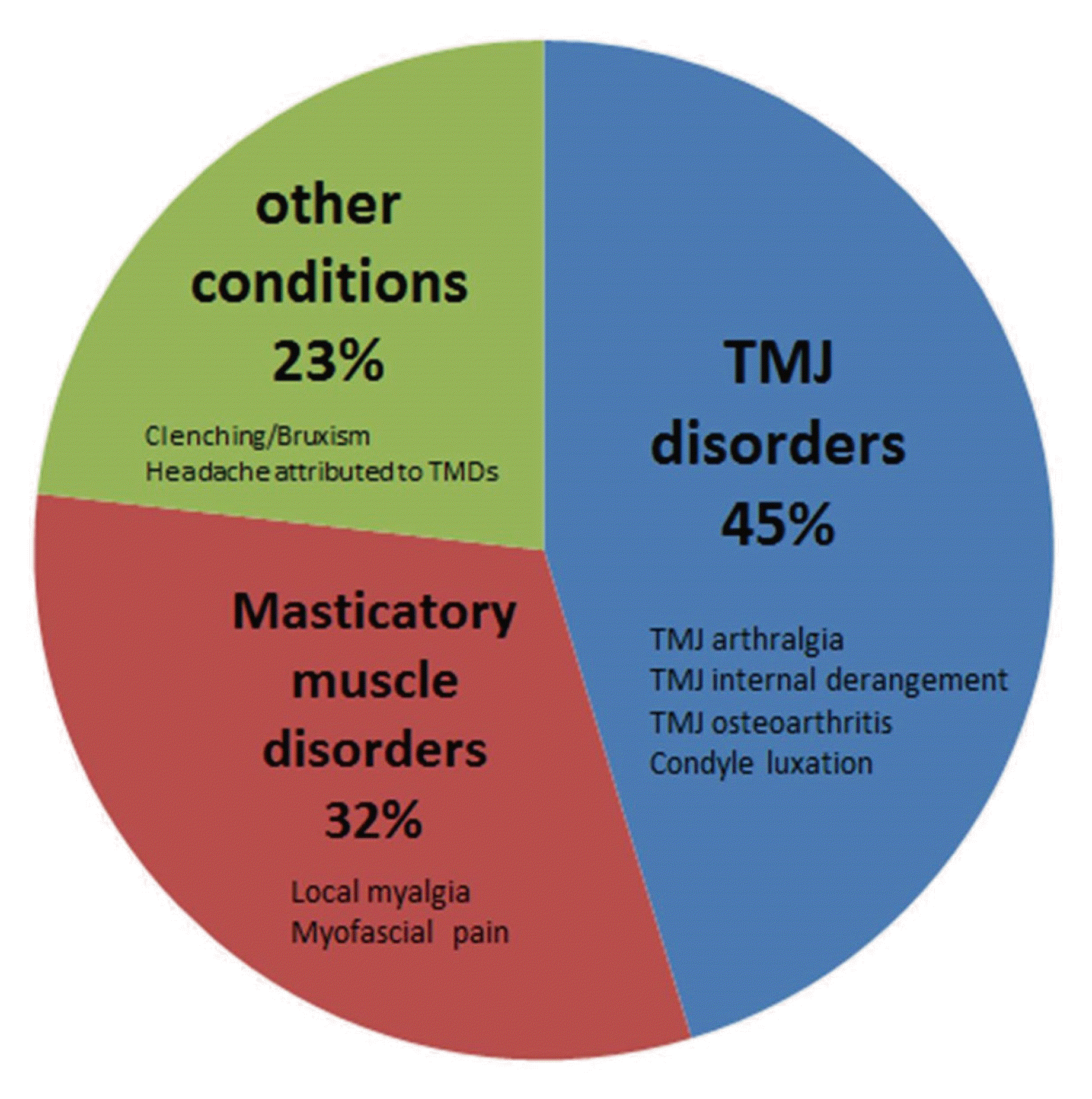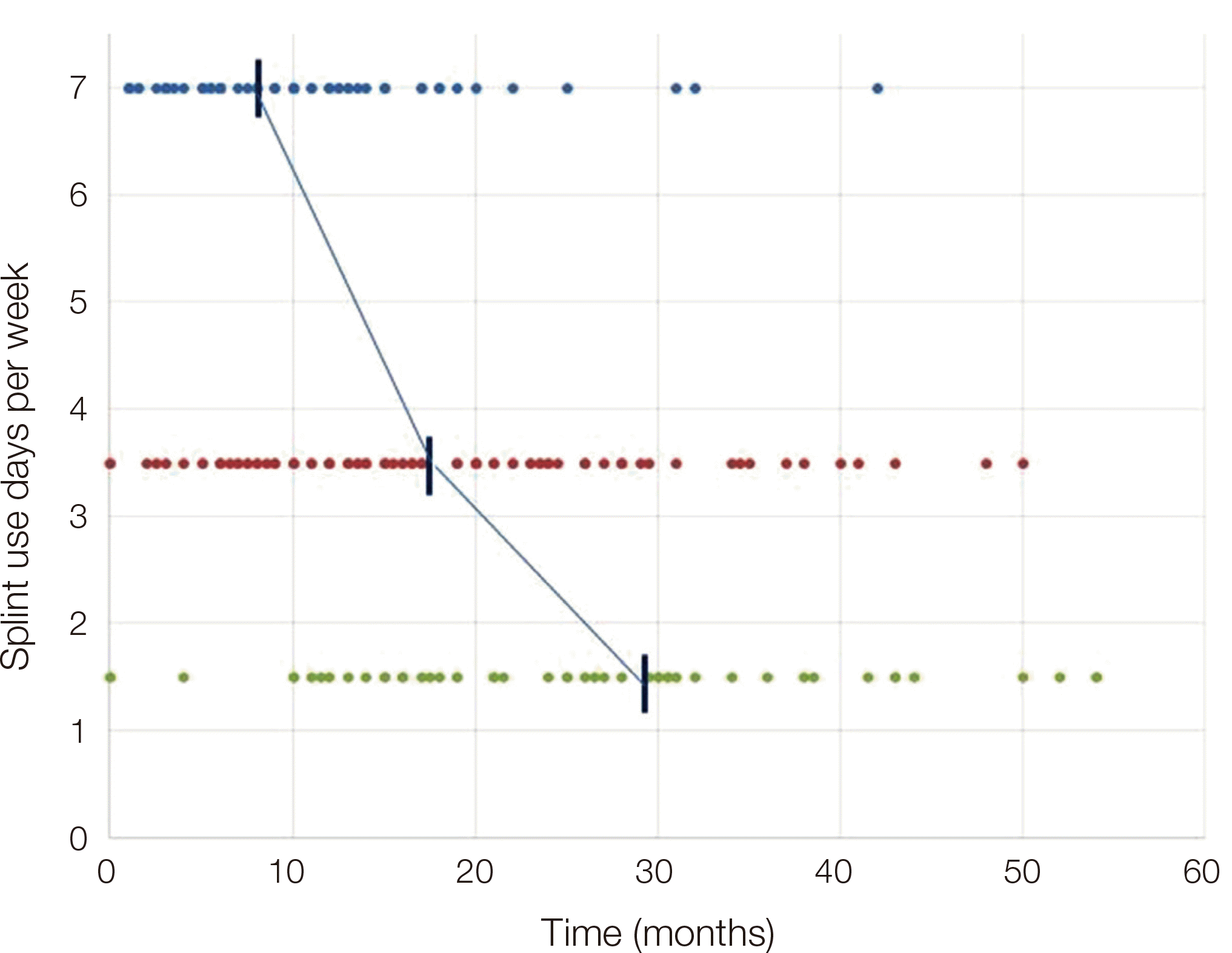1. Lee HJ, Kim ST. 2020; A questionnaire-based study of sleep-wake patterns and sleep quality in a TMJ and orofacial pain clinic. Cranio. 38:213–20. DOI:
10.1080/08869634.2018.1550134. PMID:
30477395.
2. Alajbeg IZ, Boric Brakus R, Brakus I. 2018; Comparison of amitriptyline with stabilization splint and placebo in chronic TMD patients: a pilot study. Acta Stomatol Croat. 52:114–22. DOI:
10.15644/asc52/2/4. PMID:
30034010. PMCID:
PMC6047595.
3. Peck CC, Goulet JP, Lobbezoo F, Schiffman EL, Alstergren P, Anderson GC, de Leeuw R, Jensen R, Michelotti A, Ohrbach R, Petersson A, List T. 2014; Expanding the taxonomy of the diagnostic criteria for temporomandibular disorders. J Oral Rehabil. 41:2–23. DOI:
10.1111/joor.12132. PMID:
24443898. PMCID:
PMC4520529.
4. de Resende CMBM, de Oliveira Medeiros FGL, de Figueiredo Rêgo CR, Bispo ASL, Barbosa GAS. 2021; de Analysis of splint weaning in Temporomandibular disorder patients Almeida EO. Short-term effectiveness of conservative therapies in pain, quality of life, and sleep in patients with temporomandibular disorders: A randomized clinical trial. Cranio. 39:335–43. DOI:
10.1080/08869634.2019.1627068. PMID:
31204605.
5. Zhang C, Wu JY, Deng DL, He BY, Tao Y, Niu YM, Deng MH. 2016; Efficacy of splint therapy for the management of temporomandibular disorders: a meta-analysis. Oncotarget. 7:84043–53. DOI:
10.18632/oncotarget.13059. PMID:
27823980. PMCID:
PMC5356643.
6. Akbulut N, Altan A, Akbulut S, Atakan C. 2018; Evaluation of the 3 mm Thickness Splint Therapy on Temporomandibular Joint Disorders (TMDs). Pain Res Manag. 2018:3756587. DOI:
10.1155/2018/3756587. PMID:
30651901. PMCID:
PMC6311873.
7. Pedroni CR, De Oliveira AS, Guaratini MI. 2003; Prevalence study of signs and symptoms of temporomandibular disorders in university students. J Oral Rehabil. 30:283–9. DOI:
10.1046/j.1365-2842.2003.01010.x. PMID:
12588501.
9. van Grootel RJ, Buchner R, Wismeijer D, van der Glas HW. 2017; Towards an optimal therapy strategy for myogenous TMD, physiotherapy compared with occlusal splint therapy in an RCT with therapy-andpatient-specific treatment durations. BMC Musculoskelet Disord. 18:76. DOI:
10.1186/s12891-017-1404-9. PMID:
28183288. PMCID:
PMC5301345.
11. Song YL, Yap AU. 2018; Outcomes of therapeutic TMD interventions on oral health related quality of life: A qualitative systematic review. Quintessence Int. 49:487–96. DOI:
10.3290/j.qi.a40340. PMID:
29700502.
12. Armijo-Olivo S, Pitance L, Singh V, Neto F, Thie N, Michelotti A. 2016; Effectiveness of Manual Therapy and Therapeutic Exercise for Temporomandibular Disorders: Systematic Review and Meta-Analysis. Phys Ther. 96:9–25. DOI:
10.2522/ptj.20140548. PMID:
26294683. PMCID:
PMC4706597.
13. Al-Ani Z, Gray RJ, Davies SJ, Sloan P, Glenny AM. 2005; Stabilization splint therapy for the treatment of temporomandibular myofascial pain: a systematic review. J Dent Educ. 69:1242–50. DOI:
10.1002/j.0022-0337.2005.69.11.tb04023.x. PMID:
16275687.
14. Lin SL, Wu SL, Ko SY, Yen CY, Yang JW. 2017; Effect of Flat-Plane Splint Vertical Thickness on Disc Displacement Without Reduction: A Retrospective Matched-Cohort Study. J Oral Maxillofac Surg. 75:1627–36. DOI:
10.1016/j.joms.2016.12.047. PMID:
28157490.
15. Klasser GD, Greene CS. 2009; Oral appliances in the management of temporomandibular disorders. Oral Surg Oral Med Oral Pathol Oral Radiol Endod. 107:212–23. DOI:
10.1016/j.tripleo.2008.10.007. PMID:
19138639.
16. He S, Wang S, Song F, Wu S, Chen J, Chen S. 2021; Effect of the use of stabilization splint on masticatory muscle activities in TMD patients with centric relation-maximum intercuspation discrepancy and absence of anterior/lateral guidance. Cranio. 39:424–32. DOI:
10.1080/08869634.2019.1655861. PMID:
31429383.
17. Zhu H, He D, Yang Z, Song X, Ellis E 3rd. 2019; The effect of disc repositioning and post-operative functional splint for the treatment of anterior disc displacement in juvenile patients with Class II malocclusion. J Craniomaxillofac Surg. 47:66–72. DOI:
10.1016/j.jcms.2018.09.035. PMID:
30497948.
18. Kuzmanovic Pficer J, Dodic S, Lazic V, Trajkovic G, Milic N, Milicic B. 2017; Occlusal stabilization splint for patients with temporomandibular disorders: Metaanalysis of short and long term effects. PLoS One. 12:e0171296. DOI:
10.1371/journal.pone.0171296. PMID:
28166255. PMCID:
PMC5293221.
19. Nitzan DW. 1994; Intraarticular pressure in the functioning human temporomandibular joint and its alteration by uniform elevation of the occlusal plane. J Oral Maxillofac Surg. 52:671–9. DOI:
10.1016/0278-2391(94)90476-6. PMID:
8006730.
20. Vrbanovic E, Alajbeg IZ. 2019; Long-term Effectiveness of Occlusal Splint Therapy Compared to Placebo in Patients with Chronic Temporomandibular Disorders. Acta Stomatol Croat. 53:195–206. DOI:
10.15644/asc53/3/1. PMID:
31749451. PMCID:
PMC6820445.
21. Perez CV, de Leeuw R, Okeson JP, Carlson CR, Li HF, Bush HM, Falace DA. 2013; The incidence and prevalence of temporomandibular disorders and posterior open bite in patients receiving mandibular advancement device therapy for obstructive sleep apnea. Sleep Breath. 17:323–32. DOI:
10.1007/s11325-012-0695-1. PMID:
22477031.
22. Okeson JP. 2013. Management of temporomandibular disorders and occlusion. 7th ed. Elsevier;St. Louis: p. 364.
23. Pertes RA, Gross SG. 1995. Clinical management of temporomandibular disorders and orofacial pain. Quintessence Pub;Chicago: p. 65.




 PDF
PDF Citation
Citation Print
Print






 XML Download
XML Download